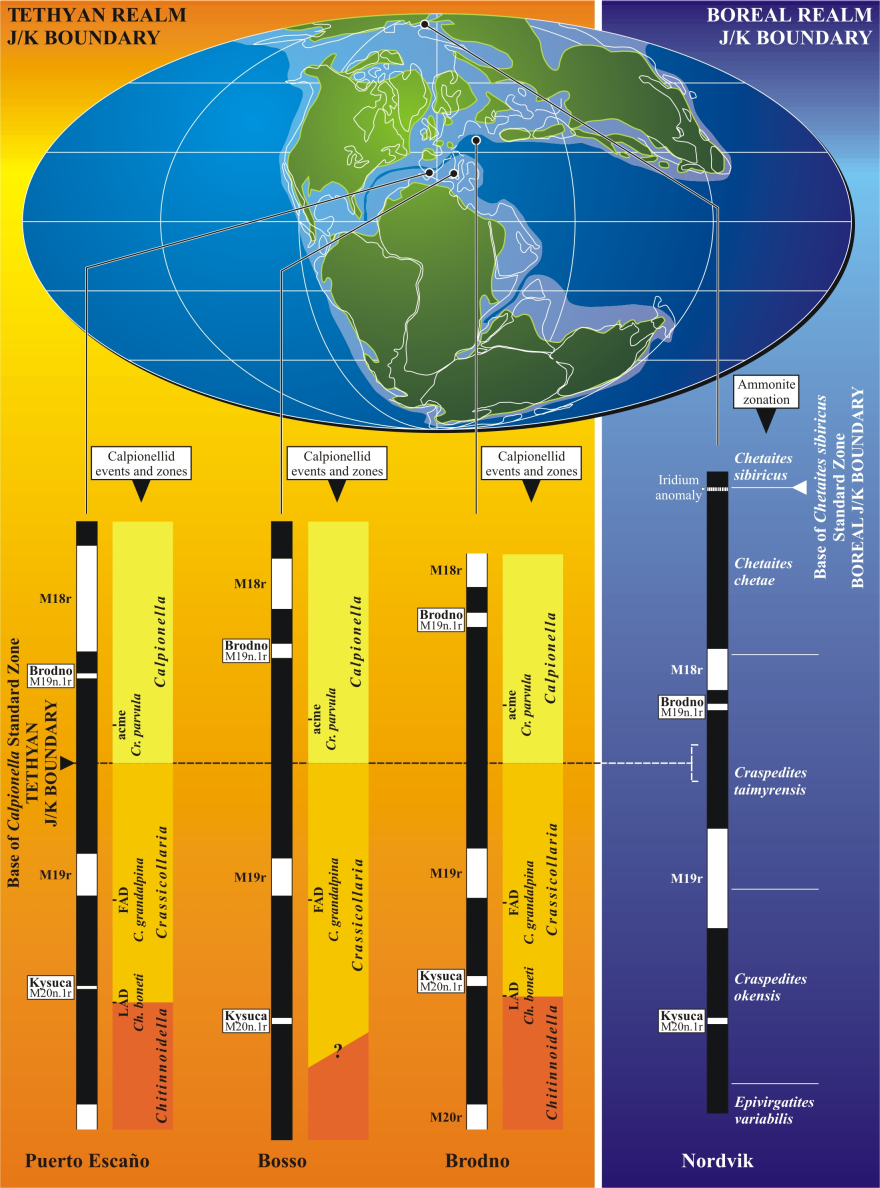Magnetic Geochronology
Magnetic geochronology utilizes the Earth's magnetic field behavior recorded in magnetic remanence of rocks to add time constrains to rock sequences in addition to the traditional dating methods. The Earth's magnetic field changes over characteristic times which range from a fraction of a second to hundreds of thousands or millions of years. Since the field direction and intensity are, under favorable conditions, recorded by the rocks, their variations over times exceeding some years can be unravelled by measurements of the remanent magnetization. Magnetic analysis of rocks of increasing age enables us to trace the history of the magnetic field and paleomagnetism can be thus used as a chronological tool. The polarity, direction and intensity of measured magnetic remanence are compared with reference curves and the relative age is derived as in the traditional geological chronology (fossil record, isotope curves, etc.). Methods and techniques differ according to the age and the time resolution needed. We may roughly distinguish between the investigation of (paleo-)secular variation (archaeomagnetism) and magnetic stratigraphy which covers all age ranges of the Earth's geological history.
Case study

Deatiled magnetostratigraphy in various cross sections covering Jurassic / Cretaceous boundary.
The Boreal and the Tethyan Jurassic/Cretaceous boundary strata were successfully correlated for the first time using high resolution magnetostratigraphic investigations together with detailed microbiozonation. The Tethyan Realm: Puerto Escaño (Spain), Bosso (Italy), Brodno (Slovakia). The Boreal Realm: Nordvik (Russian Arctica). The detailed magnetostratigraphic and biostratigraphic investigation of the Nordvik section precisely determined the boundaries of two reverse magnetozones (M18r, M19r) including two reverse subzones M20n.1r “Kysuca Subzone” in M20n, and M19n.1r “Brodno Subzone” in M19n, and established a correlation between magnetostratigraphic data (reflecting global events) and the Boreal ammonite zonation. Courtesy P. Pruner.Magnetic geochronology potentially has several enormous advantages over traditional geochronological methods because the magnetic reversals are synchronous all over the world and their polarity does not depend on geographic location and secular and paleosecular variations are usually consistent at continental scale. Magnetic geochronology has very high resolution power since the time required for a polarity transition is in the order of some thousand years which usually represents little more than an instant in the geological history of studies rock samples. Magnetic geochronology is independent of the facies; all rock types formed in a given region at a given time recorded the same magnetic field.
For that purpose of magnetic geochronology we can conveniently employ an AGICO Spinner Magnetometer (current models are JR-6 / JR-6A) which is especially designed to measure the natural remanent magnetization of oriented paleomagnetic samples. To demagnetize the samples in order to clear the recorded magnetization from undesired secondary components (e.g. viscous magnetization) we can employ an AGICO AF Demagnetizer (current model is LDA5) which can be optionally coupled with an AGICO Anhysteretic / Pulse Magnetizer (current model is PAM1) especially useful in identifying magnetic minerals and thus evaluating the origin and stability of magnetic remanence (for more details see Magnetic Mineralogy). Paleomagnetic data can be very easily processed and visualized by AGICO Remasoft software which gained a wide popularity due to its easy-to-control and straight forward user interface.
References
Houša, V., Pruner P., Zakharov V.A., Kostak M., Chadima M., Rogov M.A., Šlechta S., and Mazuch M., 2007, Boreal - Tethyan Correlation of the Jurassic – Cretaceous Boundary Interval by Magneto- and Biostratigraphy., Strat. Geo. Cor.,15, 3:297-309. DOI
Pruner, P., Houša, V., Olóriz, F., Košták, M., Krs, M., Man, O., Schnabl, P., Venhodová, D., Tavera, J. M. and Mazuch, M., 2010, High-resolution magnetostratigraphy and biostratigraphiczonation of the Jurassic/Cretaceous boundary strata in the Puerto Escaño section (southern Spain). Cret. Res., 31, 192–206. DOI
